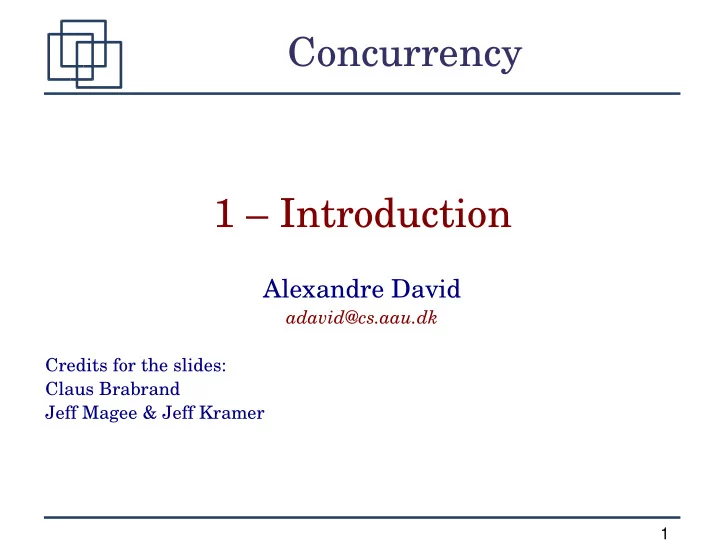

Concurrency 1 – Introduction Alexandre David adavid@cs.aau.dk Credits for the slides: Claus Brabrand Jeff Magee & Jeff Kramer 1
Course ➢ Teachers: – Alexandre David adavid@cs.aau.dk – Emmanuel Fleury fleury@cs.aau.dk ➢ Page: http://www.cs.aau.dk/~adavid/teaching/MTP-05/ ➢ Lectures: – tuesdays/fridays 8h-12h – lecture + exercises – follow the Concurrency book + additional materials 2
Materials ➢ Concurrency – State Models and Java Programs , by Jeff Magee and Jeff Kramer. ➢ Other useful books, see on the web site [3] [4] [5] in particular. ➢ Other materials: – slides – photocopies – recommended readings on the web 3
Concurrency State Models and Java Programs Jeff Magee and Jeff Kramer adapted by Claus Brabrand modified by Alexandre David 4
Why this Course? ➢ Story: Between 1985 and 1987, a computer controlled therapy radiation machine , the Therac-25, caused 6 known accidents with massive overdoses causing serious injuries and deaths. The fault came from race conditions between concurrent activities in the control program. ➢ Lesson: If you are going to design Therac-26, then do it right. 5
Is it Useful? ➢ Concurrent programming is used in a wide range of applications, most are either: – life critical – money critical – important for quality of life ➢ This course is about the principles and practices of concurrent programming. ➢ It is useful even if you don't design Therac- 26. 6
Concurrent Programs ➢ Example: activities involved in building a house include bricklaying, carpentry, plumbing, electrical installation, painting... Some activities may occur at the same time and have precedence constraints (no painting before bricklaying). ➢ It is similar for computer programs: execution of a program (or subprogram) is termed as a process . ➢ Concurrent programs are often interleaved. 7
What is a Concurrent Program? ➢ Sequential program: one process , one single thread of control. – sequential computations only ➢ Concurrent program: one or more processes , one or more threads of control per process . – multiple computations in parallel – control of several activities at the same time 8
Advantages of Concurrent Programming ➢ Performance gain from multiprocessing hardware – parallelism – future of computing (multi-core CPU) ➢ Increased application throughput – I/O calls block only their threads ➢ Increased application responsiveness – high priority threads for user requests – reactive systems 9
Advantages and Drawbacks! ➢ More appropriate program structure – concurrency reflected in programs ➢ But it is more difficult to reason about concurrent activities than sequential activities: – shared resources – mutual exclusion – preemption – precedence constraints – how to write and debug!!! – etc... 10
Be Careful! ➢ Therac-25: concurrent programming error with race conditions – caused deaths. ➢ Mars Rover: problems with interaction between concurrent tasks (deadlock caused by a priority inversion of tasks holding shared resources) that caused periodic software resets – not nice when it is on Mars! ➢ We need to be rigorous. 11
Cruise Control Example ➢ Requirements: controlled by 3 buttons ( resume, on, off ) with simple rules for the behaviour. ➢ How to design such a program? ➢ How to ensure the programs meets its specifications? ➢ How to define the specifications? ➢ How to define unsafe behaviours? 12
Java Applet Cruise control buttons ♦ Is the system safe? ♦ Would testing be sufficient to discover all errors? 13
Cruise Controller cont. ➢ What you would do: – use your own experience and design it as best as you can. – test it with a simulator of some kind, use a number of scenarios or test cases . ➢ Testing is difficult: how much testing do we need? Coverage problems. ➢ Note: concurrent events may occur in any order, difficult to (re-)produce right/wrong sequences. 14
Let's Make a Model! ➢ A model is a simplified representation of the real world that focuses on certain aspects to analyze properties. For us: concurrency . ➢ Based on Labelled Transition Systems (LTS) . engineOff speed EngineOff = engineOn-> EngineOn EngineOn = engineOff-> EngineOff EngineOff EngineOn | speed-> EngineOn engineOn 15
LTSA ➢ LTSA in Java provided on the CD of the book. ➢ Animation of models to visualize behaviours. ➢ Mechanical verification of safety properties. Engineers use models to gain confidence in the adequacy and validity of a proposed design 16
State Machines ➢ States: indicate in which states the system is in, e.g., engine switched on or off . ➢ Transitions between states: when given events occur or actions are taken, the system changes state. ➢ The point is to analyse the behaviour of the system before it is implemented. ➢ Analysis done by a model-checker . When prooblems are found, it generates the sequence of actions that lead to the problem. 17
Practice ➢ Java used for the examples: – widely available, accepted, and portable – provides good concurrency abstractions ➢ Later in the course, C: – common on all operating systems ”Toy problems”: crystallize concurrency programming issues and problems! 18
Course Objectives This course is intended to provide a sound understanding of the concepts , models and practice involved in designing concurrent software. ➢ Concepts: thorough understanding of concurrency problems and solution techniques. ➢ Models: provide insight into concurrent behaviour and aid reasoning about particular designs. ➢ Practice: programming practice and experience. 19
Course Outline ♦ Processes and Threads ♦ Concurrent Execution ♦ Shared Objects & Interference Concepts ♦ Monitors & Condition Synchronization Models ♦ Deadlock Practice ♦ Safety and Liveness Properties ♦ Model-based Design ♦ Dynamic systems ♦ Concurrent Software Architectures ♦ Message Passing ♦ Timed Systems 20
Summary ➢ Concepts: Model based approach for the design and construction of concurrent programs. ➢ Models: Finite State models to represent concurrent behaviours. ➢ Practice: Java and C for constructing concurrent programs. 21
Recommend
More recommend